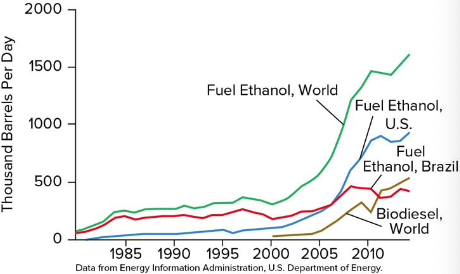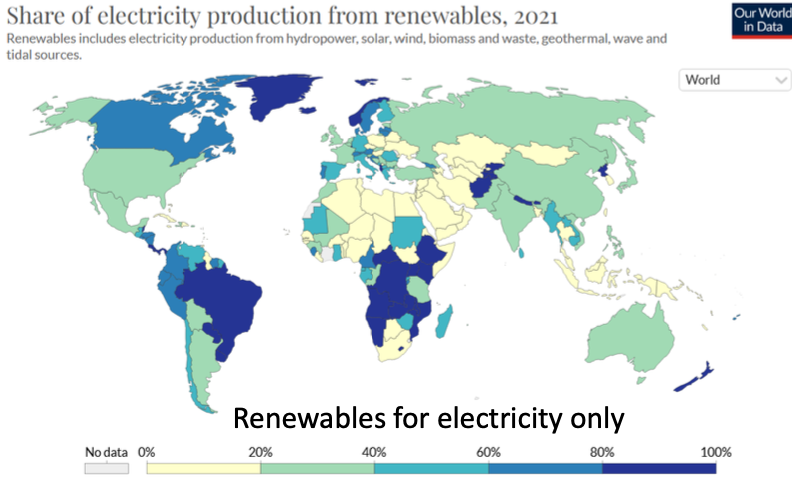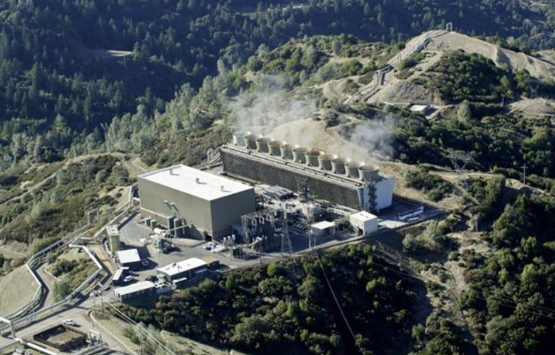Alternative Energy Sources
Need for Alternate Energy Sources
- Limitation of Fossil Fuels
- Fossil fuels are not renewable
- Most types are running out
- Lots of coal but high environment cost
- from fossil fuels climate change
- Demand of energy growing
- Increased conservation is necessary
- Need to not only augment but eventually replace fossil fuels
Alternative Forms of Energy
Three broad categories:
- Nuclear
- Hydropower
- Renewables
Nuclear Power: Fission and Fusion, Solar Energy, Geothermal Energy, Hydropower, Ocean Energy, Wind Energy, Biofuels
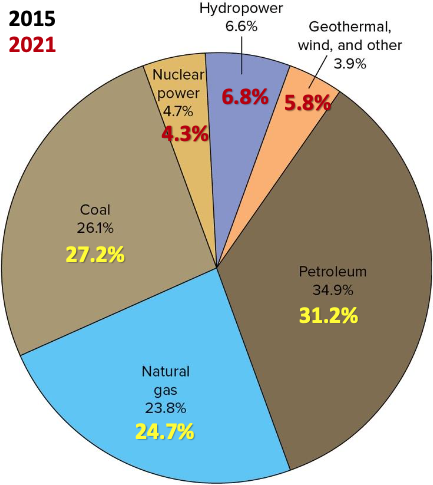
- Renewables increased at fastest rate in 2 decades, despite 2020 lockdowns
- Electric vehicles also set new sales records in the last few years
Regional consumption pattern 2020:


Power, Energy, Electricity
- Beware when using and reading words like these
- Power is the rate to do work (convert energy or generate electricity)
- Electricity vs Energy
- Energy usually includes transport and heating
- Electricity is a form of energy
- Many of the sources of power we will discuss cannot be used for transport but will generate electricity or be used for heating
- Switching to electric-powered transport or heating is preferable as electricity is more readily powered by renewable sources of energy
Nuclear Power - Fission vs. Fusion
Nuclear Power
- Fission: splitting apart of atomic nuclei into smaller ones
- Fusion: combining of smaller atomic nuclei into larger ones
- Both release energy
- Fission only commercially feasible of the two
Fusion
- Fusion: combining of two or more smaller atomic nuclei into a large one
- How the sun generates heat: two hydrogen into a helium
- Heavier isotopes of hydrogen ( & ) used
- Helium (product) is nontoxic, inert gas
- Less radioactive byproduct than fission
- Requires extreme heat (millions of degrees), but gases expand, and no material can handle that heat
- Experimental work occurring but limited investment for now

Article: https://www.nationalgeographic.com/science/article/scientists-achieve-breakthrough-nuclear-fusion
Fission
-
Nuclear reactors use the fission process
-
of Uranium occurs as U-238
- It is radioactive and supplies of Earth’s internal heat
- But cannot sustain the chain reaction needed to be useful in a nuclear reactor
- Can be used after a neutron is fired at it to form Pu-239, which is more fissile
-
U-235 fuels most fission reactors
- Most fissile, but only make sup of all Uranium
- Most reactors still contain U-238 in it because they gather a bunch of Uranium and separate out the isotopes to try to enrich their Uranium in U-235
-
Thorium-232 can also be used (but requires other U and Pl elements too)
-
Fire a neutron at a U-235 nucleus to begin the chain reaction
-
U-235 is hit by a neutron and absorbs it, becomes unstable, and splits into 2 smaller/lighter nuclei
-
More neutrons released and hit other U-235 nuclei… Hence a chain reaction continues that releases energy
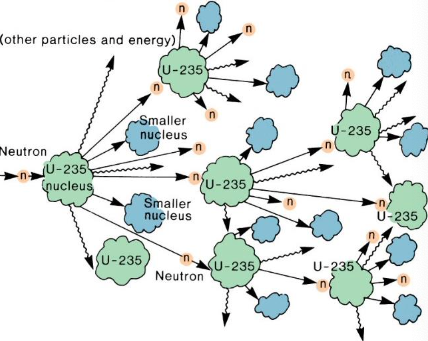
-
That energy heats cooling water circulating within the core of the reactor
-
This heat is transferred through heat exchangers to outer loops where steam is produced to run turbines for electricity
-
of uranium deposits found in sedimentary (or metasedimentary) rocks, e.g., sandstone
-
U weathered crust in small amounts, dissolved in solution and enters permeable rock layers via groundwater
-
It precipitates and concentrates in that layer that is the mined
-
Must mine the ore, then mill it to extract U, then enrich it in U-235 (most is U-238)
-
Formerly, open pit or underground mines used, but now in situ leaching
- -enriched water circulated through rock layer, dissolves U, then pumped to surface and dried to form uranium oxide (): “yellowcake”

- Canada’s Cigar Lake (Northern SK) was largest uranium producer in 2021

-
Conventional reactors are Burner reactors that use up the fuel
- Need to import more uranium or have another source for fission
-
Breeder reactor: Use surplus neutrons to produce more fissile fuels and maximize the production of other radioactive fuels
- Very complex process
- Takes decades to start producing more fuel than is used
- Very expensive (~\10$ billion per reactor)
- Very few breeder reactors exists currently
-
World reserves are difficult to know because of secrecy (i.e., nuclear weapons)
-
Reserves strongly follow price
- As price goes up, more reserves in market

- As price goes up, more reserves in market
-
of uranium is produced in:
- Kazakhstan
- Canada
- Australia
- Namibia
- Niger
- Russia
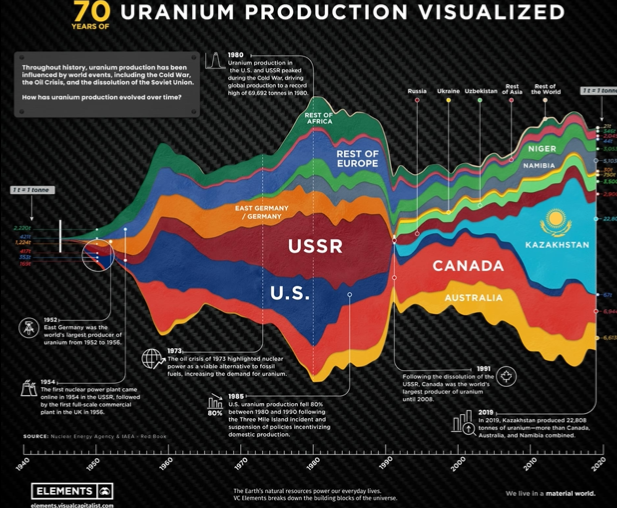
-
After dissolution of USRR in 1991, Canada became dominant uranium supplier
-
As of early 2000s, it is Kazakhstan
-
Uranium is finite
-
Nuclear is NOT a renewable energy source but it is clean no GHG emissions
-
US cannot increase rate of nuclear domestically!
- 4x more output ( of energy need) would deplete reserves in a few decades
-
Need better technology
-
Safety concerns related to nuclear reactor
- During operation, small harmless amounts of radiation released
-
Damage and disruption to operation is a concern
-
Biggest fear: Reduction in cooling water flow to the reactor
- Overheating and potential core meltdown
-
Three Mile Island accident (1979)
- Clogged filter they couldn’t clear; Forced water through to clear it but forced water through an air line that caused the turbines to shut down and stop receiving heated coolant water
- Reactor started overheating and some emergency back up operations failed
- Enriched coolant water was released and 35-45% of core melted

-
Safety concerns related to fuel and waste handling
-
Miner cancer rates elevated and tailings are radiocative
-
Plutonium from breeder reactors is radioactive, toxic, and can be used for nuclear weapons
-
Nuclear waste disposal
- Radioactive materials cannot be made nonradioactive: emit for thousand of years
- Still no consensus on how to dispose so it’s in temporary sites
- Decommissioning after year lifetime: most of the structural part is also radioactive
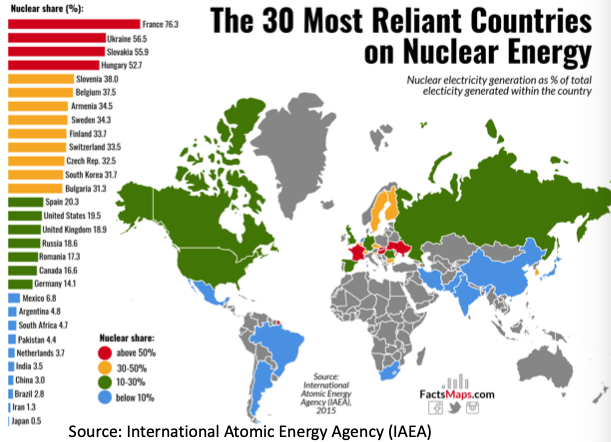
- Use of nuclear varies globally
- Disasters make people think twice
Solar Energy
Abundant solar energy reaches the Earths surface
- Much of it reflected or dissipated so why not use it?!
- Energy far exceeds our needs and sun will burn for 5 million years
- Solar energy is free, clean, and a renewable resource
Obvious limitations: are latitude and climate (i.e., amount of sun) and Storage of energy when not needed.
- Solar Heating
- Passive solar heating: no mechanical assistance
- Active solar heating: mechanical circulation of solar-heated water
- Solar Electricity
- Photovoltaic cells
Passive-solar heating
- Low south-facing windows maximize heat in the winter
- Overhangs on windows block light from above in the summer - shading windows fo cooling
- Thermal mass = construction materials that absorb, store, and release heat
- Planting vegetation in strategic locations
- By heating buildings in winter and cooling them in summer, passive solar methods conserve energy and reduce costs

Active-solar heating
- Flat plate solar collectors (solar panels) = one active method for harnessing solar energy for heat
- Water, air, or antifreeze pass through collectors, transferring heat throughout building
- Heated water is stored and used later

Solar Electricity
- Photovoltaic cells (PV): (also called solar cells) collect sunlight and convert it into electrical energy
- When light strikes one of a pair of metal plates in a PV cell, it cause the release of electrons which creates an electric current
- No moving parts, no pollutants emitted
- But expensive
- Technology not efficient and not mass produced
- Solar energy output is not efficient
- Strongest sunlight in US = 250
- Commercial solar cells only efficient = 50
- Need of collector to run a single 100-watt lightbulb
- Solar is not efficient for scaling up requires lots of land and resources
Solar Electricity without PVs:
-
Mirrors are spread across wide expanses of land to concentrate sunlight onto a receiver atop a tower containing molten salt. The heated salt in turn heats water to make steam for to run turbines.

- Parabolic mirrors focus sunlight on tubes of water that then makes steam to power turbines. But mirrors are also resource intensive (silver or aluminum)

- Parabolic mirrors focus sunlight on tubes of water that then makes steam to power turbines. But mirrors are also resource intensive (silver or aluminum)
One of the biggest limitations is storage
- Individual households could use batteries
- Large-scale projects need a method to hold larger amounts of energy
- Two potential methods:
- A. Use solar energy to break up into and and store ions until need the energy by recombining them or burning the hydrogen
- B. Use solar energy to pump water to elevation and release the water later to run turbines when energy needed (i.e., hydropower)

Lifespan of PV cell is ~25 years
Are PV cells recyclable?


- China is way ahead of everyone else
Geothermal Energy
Geothermal Energy
- Using heat in groundwater that has circulated near a magma chamber
- Evidence at surface in form of natural hot springs or geysers
Examples:
- Banff Hot Springs, Banff National Park, Alberta, Canada
- Old Faithful geyser, Yellowstone National Park, Wyoming, USA
Geothermal Power Plants:

- Water that is not hot enough to produce steam can still be circulated through a home to heat it, like in Iceland and Russia
Geothermal Power Plants
- The Geysers, California, USA
- Since 1960 with capacity of 2 billion watts
- Largest geothermal power complex in the world
- ~0.3% of total energy consumed in USA
Examples:
Other large steam systems in Italy, Japan, Mexico and the Philippines
Only 40 sites total worldwide
- Maybe more than just 40 geothermal power plants
- Locations align with plate boundaries (i.e., where magma is near the surface), https://www.thinkgeoenergy.com/map/

- No ash, radioactive-waste, or emissions
- But some sulfur emissions, corrosion of pipes, land subsidence and earthquakes

Major limitations of geothermal power:
- A field only lasts a few decades
- Rate of heat extraction declines as rocks become cooler; Must wait awhile for magma to heat the rock again
- The Geysers: in 1991 - 1.5 billion watts; in 2010 725 million watts
- Stationary
- Plants must be built at that location
- Long-distance transmission is not practical or inefficient
- Energy cannot be used for transportation
- Only occurs in certain locations
- Plate boundaries cover a limited area and much of it is not accessible or has limited water
- Some cannot be built on (e.g., national parks)

Alternative Geothermal Sources:
- Hot-dry-rock sites: areas of higher-than-normal geothermal gradients (>40) but limited water and not associated with plate boundaries
- Extensive areas but in low population regions with limited water
- Experimentation in USA but not economical for large scale use

- Geopressurized natural gas zones: natural gas dissolved in pore water thousands of meters below ground
- Heat from gaseous fluids could be used in theory
- Not being developed currently


Not associated with magma!:
Geothermal heat pumps (not associated with magma)
Pump water 10-20 ft below ground and use the natural 10-15 temperatures to heat water or cool water that circulates beneath your house and to your heating/cooling system.
- In winter, below ground is warmer than air and in summer it will be cooler
Hydropower
Hydropower
Hydropower operations typically consist of damming a river, flooding an area, and controlling the release of water through turbines in the dam
- Turbines are spun by water movement and produce electricity
- Four main types:
- Impoundment: flooding an area to become a reservoir
- Run-of-river: placing a dam in a river with limited flooding of area
- Diversion: diverting river water to a channel and use elevation decline to bring water to turbines (may not use a dam)
- Pumped storage: pump water uphill with solar, wind or nuclear energy and store it in a reservoir until energy needed and release down hill to turbines
- Water is not consumed
- Renewable if rivers continue to flow
- Technology for storage is known
- Very clean: no pollution from equipment and no chemicals
- But most reservoirs emit greenhouse gases
- Some emit substantial amounts, particularly in tropics

- Problems associated with dams
- Silting-up reservoirs
- Habitat destruction
- Evaporation
- Earthquakes?
- Displacement of communities
- Dam failure risk (e.g., beware of fault zones)
- Sites are hard to come by now
- Need to transmit power long distances from remote areas
- Opposition to destroying land (loss of C sink if removing tress)
- Revamping flood control dams may not work
- Must be stationary: on site power generation
- Impacted by Climate drought is the biggest issue!
Now we look at the Colorado River:
- Southwest USA’s most important river
- Water for 5 million acres of farmland
- Drinking water for 40 million people
- Hydropower for 4 million people
- Mega-drought: loss of river flow since 2000 due to climate change!
- Compounded by decades of overuse
- Hydropower may only have a few years left here…
Examples:
- Glen Canyon Dam, Arizona
- Hoover Dam, Nevada

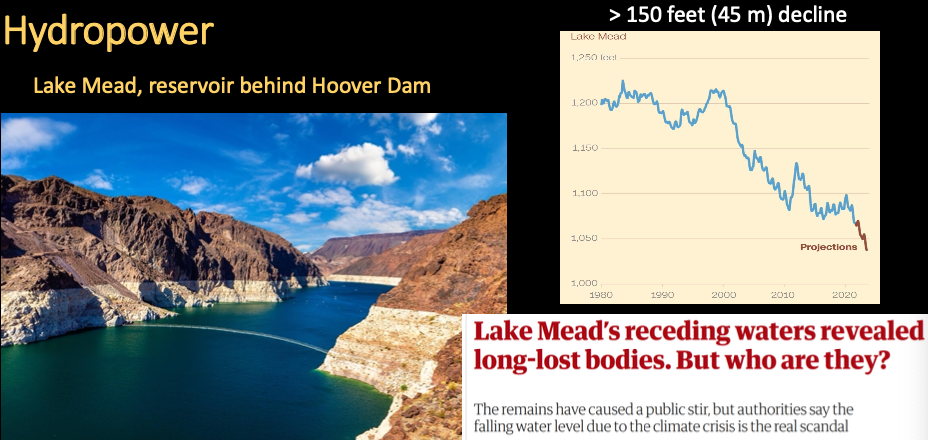

Total installed capacity in 2020:

Ocean Energy
Ocean Energy
Energy from tides, from waves, and from temperature differences between shallow and deep water
- Tidal power requires difference or a dam to store water in a bay
- But tidal differences in most areas only ~1 m so useful regions are limited
- Currently operational in Bay of Fundy (Nova Scotia, Canada), France, Netherlands, former Soviet Union
- Total potential globally is only of hydropower potential
- At least 4 attempts at tidal power in Bay of Fundy
- One was ripped apart by 18kph currents
- Latest attempt launched in 2021 with 6 wind-like turbines
- 9MW electricity for 3000 homes
Ocean Thermal Energy Conversion (OTEC)
Exploits temperature difference between warm surface water and cold deep water.
- Warm water vaporized to run a turbine (or its heat used to vaporize another liquid) and vapour is recondensed after chilled by cold water
- Clean, renewable, recondensed vapour is freshwater and can be used for water supply
- But only near shore where cold water can be reached and only where temperature difference is year-round (i.e., tropical islands)
- Only operational facilities in Japan and Hawaii, USA
Wave Energy
Exploits the constant up-and-down motion of water at the surface of the ocean.
- Drive a pump to push water through a turbines or the rise and fall of water surface in an enclosed chamber produces pulses of air to drive a turbine above
- Clean and renewable but an eyesore and disrupts sedimentation
Wind Energy
In Netherlands, Sweden, Spain, Greece.
- Renewable
- Clean
- Old technology
Limitations:
- It’s 3D and highly variable in time
- Regional variability important for local power supply
- Power generation increases with the cube of wind speed
- If wind speed doubles, power output increases by 2x2x2 = 8 times
- Needs to be windy and accessible (not too remote)
- Long distance transmission is still inefficient
- How to store it?
- Visual eyesore and noisy
- Interference with birds and bats
- Disruption of communications (e.g., tv, radio, cell)
They are mostly used to complement conventional energy sources
- Needs significantly more land
- ~250 of land for 1000 MW
- Could also be used for pasture
- Princeton University’s Net Zero America Project maps land use for various scenarios to meet net zero emissions by 2050 as proposed by President Biden.
- Most intensive has wind and solar generating 98% of USA electricity

Offshore wind farms are more consistent power suppliers than on land and can be near large cities (in Great Lakes too), but storage, aesthetics, and jurisdiction are issues.



Why does China have so much wind energy??
Renewables Likely Need More Space

Or maybe not?:

Biofuels
Biofuels
Various ways to derive energy from living biomass or their remains
- Ultimately from solar energy because of photosynthesis
- ’Unfossilized fuels’ because from recent biomass
- Sometimes need to be ‘cofired’ with conventional fuels
- May see ‘bioenergy’ and ‘biofuel’ energy for power and fuel for transport
Three broad categories:
- Wood
- Waste
- Alcohol
- All are burned so emit
- Some contribute particulate air pollutants (i.e., wood)
- But all are renewable (we can plant and use)
Waste-derived fuels
- Wood can fall here: e.g., logging waste
- Crop waste
- Urban compost
- Liquid waste research
- From animal manure
- Food-frying oil waste
- Biodiesel: vegetable oil or animal fat
- Derive alcohol fuel from plant waste
- Biogas or ‘gas from garbage’ Methane natural gas
- Landfill gas needs to be purified
- Decaying manure
Alcohol fuels (bioethanol)
- Gasohol: gasoline and alcohol/ethanol: popular during oil embargo of 1970s but some gasoline still contains ethanol
- Can design cars to run on high alcohol mixes
- E855 cars now popular: ethanol and gasoline
- 3.5 million cars and 15 million light trucks run on ethanol in USA
- But takes energy to derive ethanol from corn and drives up food prices
- 1 SUV tank full of ethanol could feed 1 person for a year
- Where to grow?
- GHG emissions
